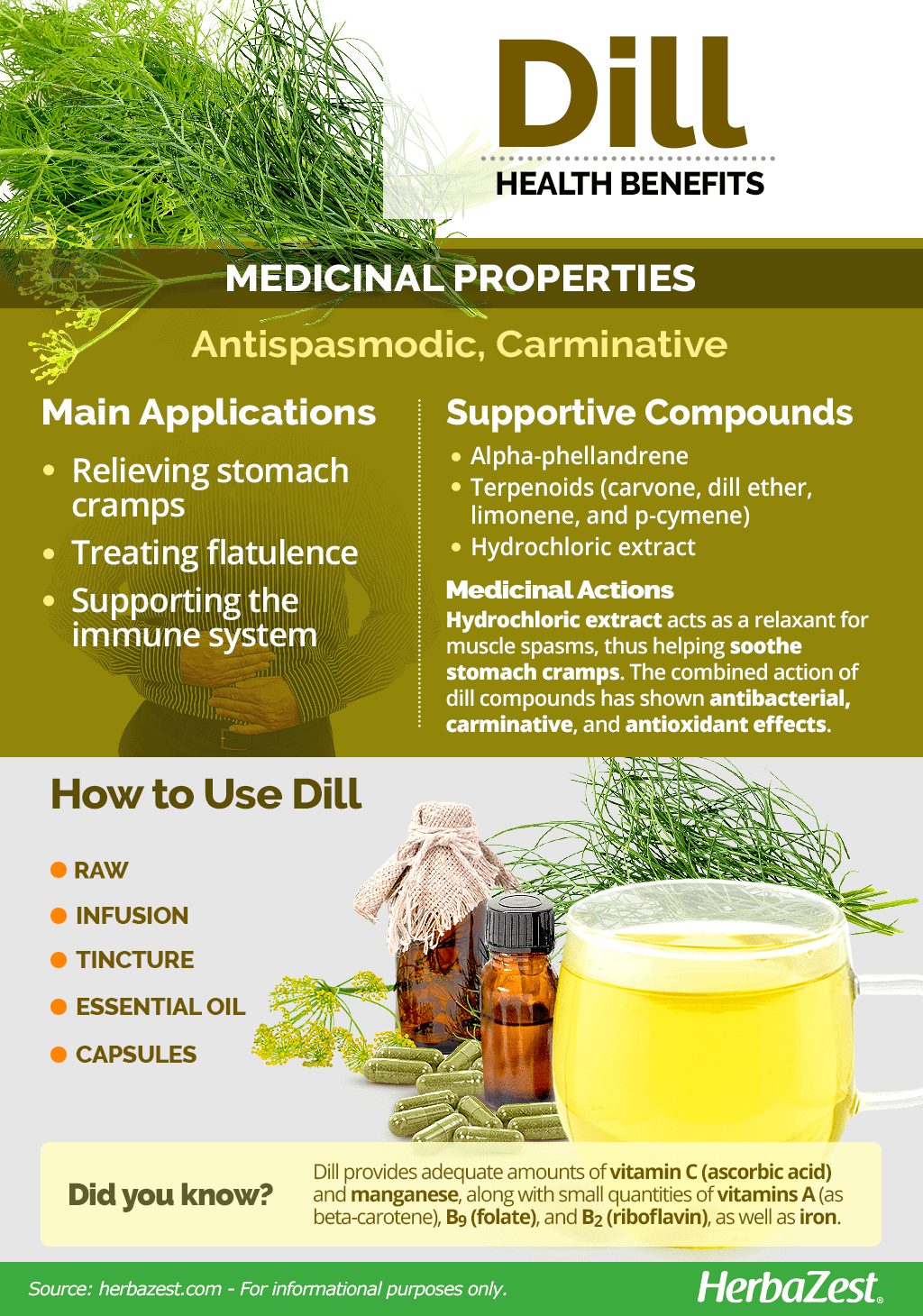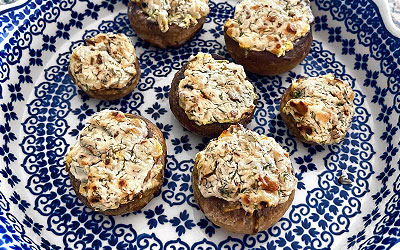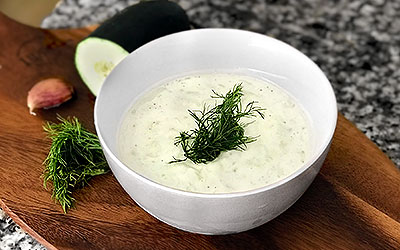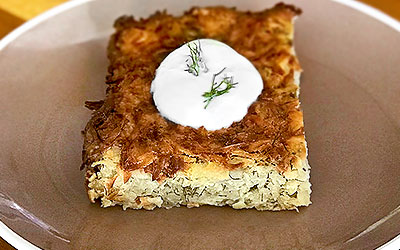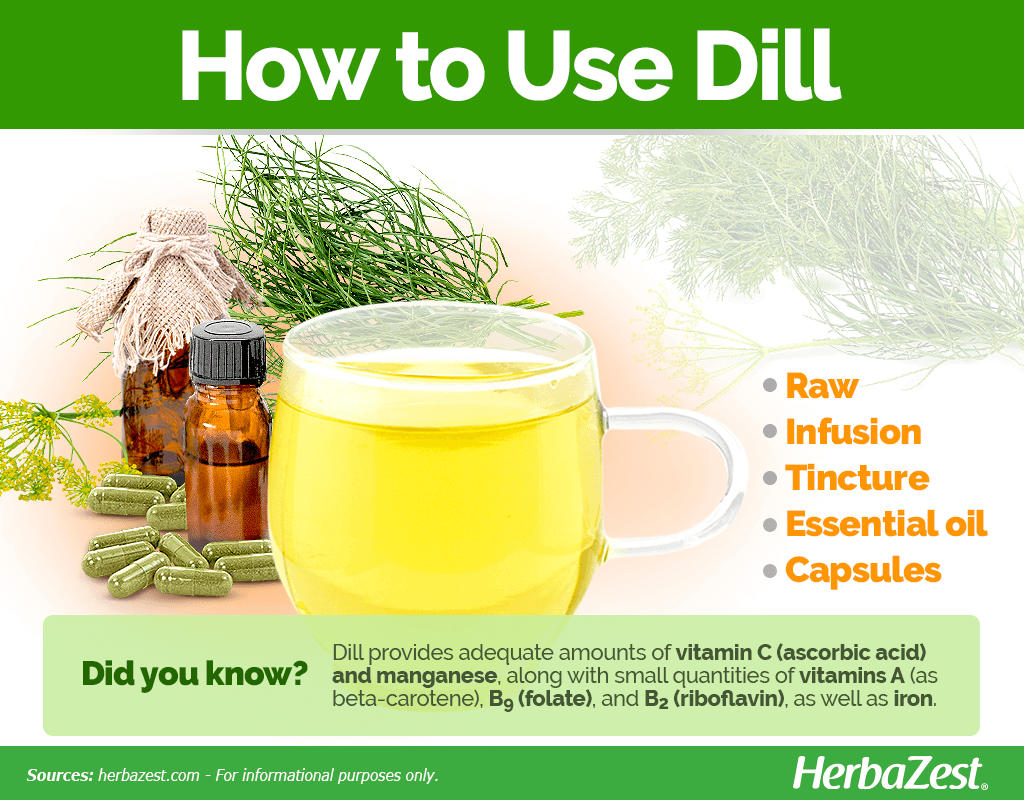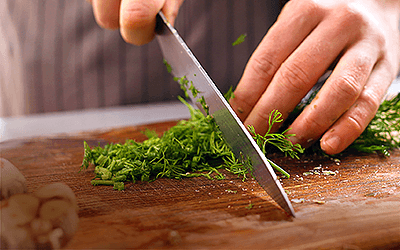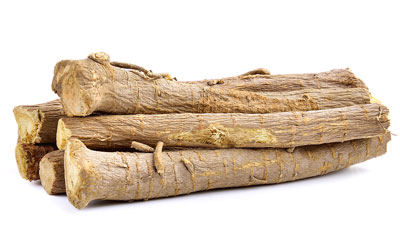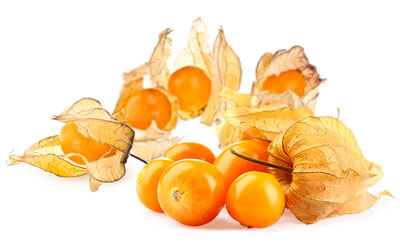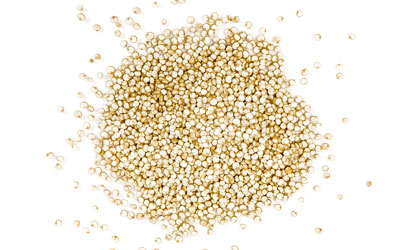Dill, an herb originating in Eastern Europe and the Mediterranean, has been widely-used spice for millennia. It is believed be a native of the widespread area between Western Russia and Northeastern Africa, and to have been domesticated first near the Russian steppes over 2,000 years ago. This early popularity of dill for the dual reasons of medicinal and culinary purposes allowed its popularity to spread throughout the world and remain a widely-consumed herb.
Dill Medicinal Properties
- Medicinal action Antispasmodic, Carminative
- Key constituents Alpha-phellandrene, terpenoids, hydrochloric extract
- Ways to use Capsules, Hot infusions/tisanes, Freshly ground, Tincture, Essential oil
- Medicinal rating (2) Minorly useful plant
- Safety ranking Use with caution
Health Benefits of Dill
There is evidence of dill being used in both cooking and medicinal applications in ancient cultures, including Roman, Greek, and Egyptian times. Its value since then has barely diminished, with the plant remaining a very popular natural remedy for many ailments. Scientific investigations suggest that the most remarkable health benefits of dill are:
Relieving stomach cramps. The medicinal properties of dill help suppress muscle spasms, therefore soothing stomach pain and irritation.
Treating flatulence. Dill has historically been used to minimize wind in the human body, and modern science has provided evidence that corroborates its carminative properties.
Supporting the immune system. The antioxidant compounds and other nutrients in dill can help the body to build defenses against bacteria and viruses.
Additionally, preliminary research suggests that dill may contribute to reducing cholesterol levels, although more studies are needed to confirm this and other touted dill benefits.
Traditionally, the medicinal properties of dill have been used for treating colic, insomnia, urinary complaints, and piles.
How It Works
Over 36 components have been identified in the dill herb; however, α-phellandrene, a terpenoid, is its dominant compound and amounts to 53% of the herb's oil; it is also the phytochemical responsible for the pleasing aroma and most health benefits of dill.
The seeds of dill also contain hydrochloric acid, which has been shown to act as a muscle relaxant, which may explain dill benefits for the treatment of stomach cramps.
Other terpenoids - such as carvone, dill ether, limonene, and p-cymene - are also major constituents of dill oil, which is extracted from the herb's leaves and seeds. Though the exact mechanism of each component has not yet been established, the combined action of these chemicals has shown antibacterial, carminative, and antioxidant effects.
Although further research is required, dill extracts have also been suggested to have antihyperlipidemic effects, which may help reduce the accumulation of fatty compounds that causes high cholesterol.
Guelder rose and linden are examples of herbs with strong antispasmodic properties, and similar carminative benefits can be found in cardamom and fennel.
Dill Side Effects
Dill is generally considered safe for oral and topical use. However, it may cause skin irritation and heightened photo-sensitivity in some people. This means that extra care should be taken if one is going to be in the sunlight. Those who are pregnant or breastfeeding should seek advice from a health professional before consuming dill in medicinal doses.
Dill Cautions
Allergic reactions to the dill herb are uncommon, but they can occur, particularly in those who are allergic to coriander, fennel, anise, caraway, asafetida, or celery. People with hypoglycemia and diabetics taking medication should be aware that consuming dill can lower blood sugar levels.
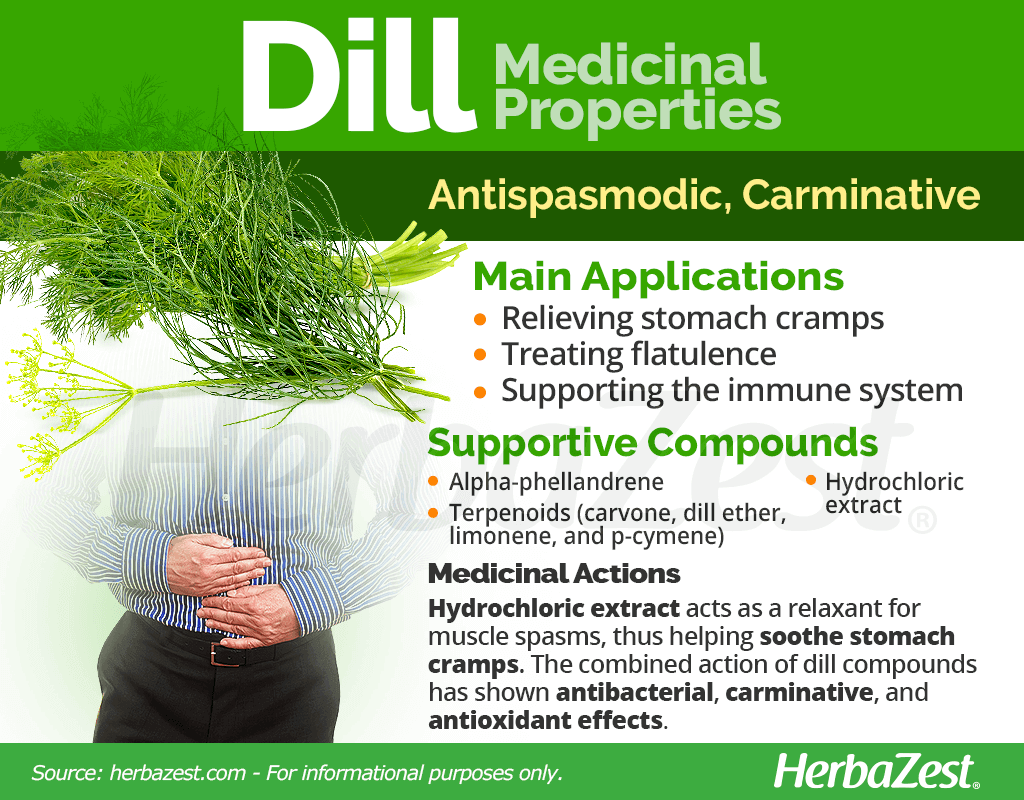
Dill Nutrition
Since dill is an aromatic herb, used mostly to lend a fresh, aniselike flavor to culinary dishes and beverages, it doesn't provide a great deal of nutrients per serving; however, it contains adequate amounts of vitamin C (ascorbic acid) and manganese, along with small quantities of many important nutrients, such as vitamin A (as beta-carotene), B9 (folate), and B2 (riboflavin), as well as iron.
Dill sprigs also provide many other vitamins and minerals in trace amounts; however, all these elements contribute to sustain a functional immune system and a general good health.
One cup of dill sprigs (about 9 g) provides 4 calories, as well as 1% of the daily value for protein and dietary fiber.
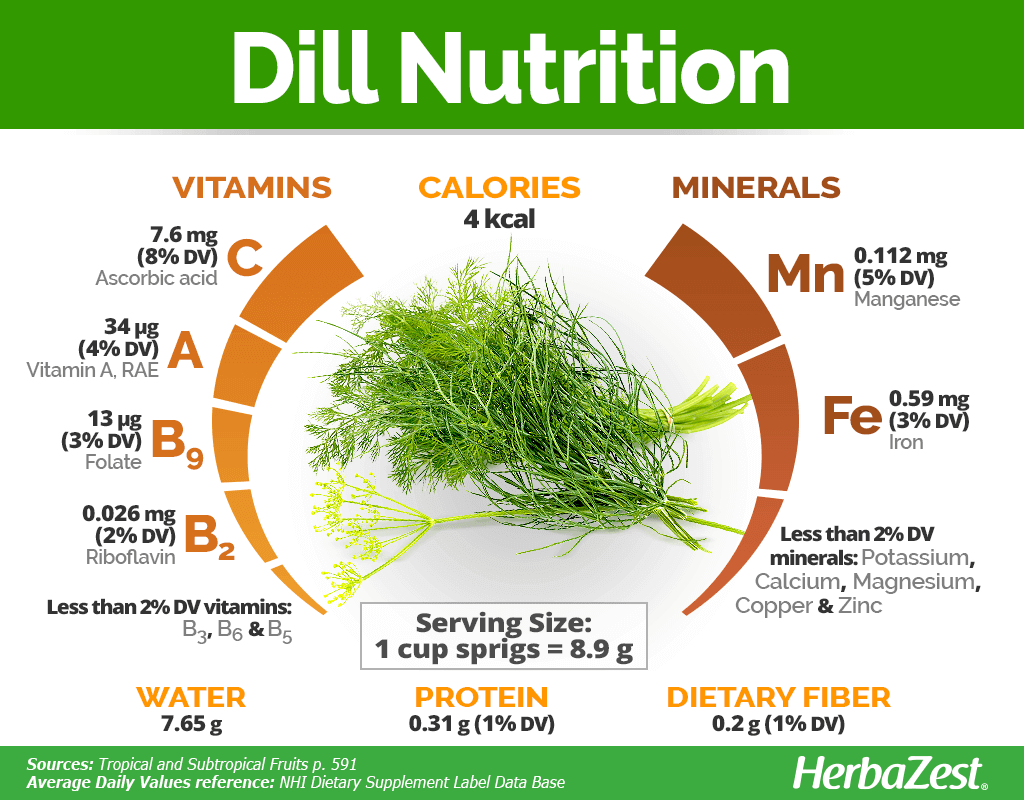
How to Consume Dill
- Edible parts Leaves, Seed
- Edible uses Flavoring
- Taste Aromatic, Sweet
All parts of the dill plant boast a unique fragrance and taste that can make many dishes more interesting. This aromatic herb is especially favored in Russia, where it is widely used for culinary purposes. Dill leaves can be consumed fresh or dried, and are also available in the form of teabags, as well as in a range of supplements, which are recommended for those looking to obtain the health benefits of dill in concentrated forms.
The dill herb has been used as a flavoring for vodka and meringue.
Natural Forms
Raw. The dill herb has a distinct anise-like, sweet, and citrusy flavor that many enjoy and add to a vast range of culinary preparations, such as sauces and dressings. As a digestive, carminative herb, dill benefits can be obtained when consumed with food.
Infusion. Fresh or dried, the whole dill plant can be brewed into a warm herbal tea, and taken to relieve flatulence and soothe digestive complaints.
Herbal Remedies & Supplements
Tincture. This concentrated form of the herb is a convenient method of reaping dill benefits for digestion and stomach cramps, and should be diluted in water.
Essential oil. Generally extracted from the seeds, it is also possible to be obtained from the leaves and stems. Dill's essential oil is often used as a relaxant. It can be applied topically or added to food.
Capsules. These may be preferred because they permit a fast intake, easy dosage adjustment, and a consistent concentration of dill medicinal properties.
Buying
- Where to buy Supermarkets, Specialized health stores, Online herb stores, Local herbal store, Organic markets, Online health stores
Natural Forms
Raw dill is easy to find at most grocery stores and local markets around the world. The most common presentations of raw dill include the dried leaves and seeds, which are sold as herbs and spices. Many supermarkets and plant nurseries now even sell dill seedlings, because adding fresh dill to a vast amount of foods has become so popular. Whether bulk or in tea bags, dried dill is available to buy online and at health food shops.
Herbal Remedies & Supplements
Tinctures, capsules, and essential oils can be found at specialized health stores, and a range of supplements are also available for purchase online through herbalist and specialized health retailers. These preparations are likely to differ in concentration, so it is important to do some previous research and read the labels carefully in order to consume the appropriate dosage.
Growing
- Life cycle Annual
- Harvested parts Seeds, Leaves
- Light requirements Full sun
- Soil Light (sandy), Medium (loam), Loamy sand, Well-drained
- Soil pH 5.6 – 6.0 (Moderately acidic), 6.1 – 6.5 (Slightly acidic)
- Growing habitat Temperate climates
- Plant spacing average 0.15 m (0.49 ft)
- Growing time Two months
- Potential insect pests Aphids
- Potential diseases Powdery mildew
The dill plant is frequently grown in gardens, not only for harvest of its aromatic leaves and seeds, but also for its ornamental foliage and its pretty, unassuming flowers. It can be grown as an annual or a perennial, depending on the surrounding conditions.
Growing Guidelines
- Dill is a hardy, fairly adaptable plant and tolerates poor soil conditions; however, it grows best in well-drained, sandy or loamy soil, with an ideal pH of 5.8 - 6.5.
- The dill plant likes hot summers, plenty of sunlight, and protection from strong winds and frost in order to be grown as a perennial.
- It tolerates cold winters and can survive temperatures as low as 25°F (-4°C), but an ideal temperature range to grow dill herb is 43 - 79°F (6 - 26°C).
- Regular watering is required; however, care should be taken not to over-water the dill plant, since this is likely to cause rotting.
- Dill seeds should be planted directly in garden soil or containers, 1/4 inch (6 mm) deep and around six inches (15 cm) apart.
- Dill leaves will be ready to be harvested within two months of planting.
- Some manual weed control is advised, and a layer of mulch on the soil around the dill plant is recommended.
- The dill herb attracts many beneficial insects, such as bees and butterflies, but it is also susceptible to aphid infestations and diseases like powdery mildew.
Additional Information
- Other uses Cosmetics, Perfume, Repellent
Plant Biology
When it is cultivated in the optimum conditions, the dill plant can grow up to 35 inches (90 cm) tall. It consists of tall, slender stems that split into four or five, and then from these develop further, short stems with feather-like leaves on them. Flowers will develop in the summer as clusters of yellow spheres known as schizocarps, which will dry and split, becoming seeds.
Classification
Dill (Anethum graveolens), is a member of the large Apiaceae group, commonly known as the carrot or parsley family, which contains 3,700 species across 434 genera. Most of its members are aromatic flowering herbs and slow-growing, woody perennials called shrublets. Apiaceae contains a large number of other economically-important species, including celery (Apium graveolens), anise (Pimpinella anisum), and coriander (Coriandrum sativum).
Varieties and Cultivars of Dill
Although Anethum graveolens is the sole member of the Anethum genus, over the course of history, many different cultivars of dill have been developed for commercial purposes. The most common is 'bouquet', which has aromatic, dark blue-green foliage and big seed heads. Other popular cultivars are 'Long Island', 'fernleaf', 'dukat', and 'superdukat'.
Historical Information
It is known that dill was highly valued in ancient times because it earned mentions in both Egyptian and Christian literature. Sprigs of dill were discovered in the tomb of Egyptian Pharaoh Amenhotep II, who died in 1400 BCE. Traces of the dill plant have also been found among Roman ruins in Great Britain.
The Greek physician Hippocrates was known to have valued dill for its cleansing powers, and soldiers of the time would use it to treat burns.
Dill's genus name Anethum is derived from aneeson, a Greek word meaning "strong smelling", and its popular name is thought to come from the Norwegian word dill (to lull), referring to the carminative properties of the herb.
Economic Data
Dill is considered an economically-important herb. Currently, India and Pakistan are its biggest producers, although the United States, Europe, and North Africa also cultivate it on a large scale. The U.S. and Russia are the biggest importers of the herb.
The International Trade Centre has carried out a survey and estimated that the annual demand for freeze-dried dill is around 300 tons for France, Germany, Britain, and the Netherlands alone.
Popular Beliefs
During the Middle Ages, dill was believed to protect against witchcraft, and people would hang it over their threshold to ward off evil spirits. This belief was held for many years, and it is mentioned in Michael Drayton's 1627 mock-epic poem Nymphidia: Or The Court of Faery, in which the lines read: 'Therewith her vervain and her dill, that hindereth witches of their will.'
It was also once thought that dill could stimulate the flow of milk in lactation, and so it was administered to women and cattle who were having difficulties nursing.
Dill was a symbol of wealth in ancient Greece and Rome.
Other Uses
Pest control. Dill has proven to be an effective pesticide, particularly when it is crossed with coriander. The substance obtained is toxic to some larvae and pests that appear in wheat flour.
Food industry. Dill extracts can also be used in some preservatives, as the compounds of the herb inhibit the growth of certain bacteria, including Staphylococcus, Streptococcus, Escherichia coli, and Pseudomonas.
Cosmetics. Dill essential oil can be found in some soaps, moisturizers, and lip balms. It has also been used in the production of perfumes due to its agreeable scent.
Dill remains a very popular herb because of its pleasant flavor and versatility. The wide range of dill benefits, along with its mainstream culinary uses, confirms the herb's position as a highly-regarded plant, which is likely to continue being widely cultivated across the world.
Sources
- Biotechnology Letters, Hairy root cultures of Anethum graveolens (dill): establishment, growth, time-course study of their essential oil and its comparison with parent plant oils, 2002
- Body Nutrition, The benefits and side effects of dill (Anethum graveolens)
- Industrial Crops and Products, Essential oil content and composition in commercially available dill cultivars in comparison to caraway, 2001
- Journal of Essential Oil Research, Chemical Composition of Essential Oil of Dill (Anethum graveolens L.) Growing in Reunion Island, 1998
- National Library of Medicine, Anethum graveolens: An Indian traditional medicinal herb and spice
- New World Encyclopedia, Dill
- Purdue University, Fact Sheets, Dill
- Texas A&M Agrilife Extension, Dill, or Dillweed (Anethum graveolens) | Easy Gardening, Dill
- USDA Plants Database, Farmer's Bulletin No. 1977: Savory Herbs: Culture and Use
- Encyclopedia of Herbal Medicine, p. 168
- Medicinal Plants of the World, p. 47
- Journal of Food Science, Chemical Constituents, Antimicrobial Investigations, and Antioxidative Potentials of Anethum graveolens L. Essential Oil and Acetone Extract, 2006
- Journal of Agricultural and Food Chemistry, Composition and content of aroma compounds in dill, Anethum graveolens L., at three different growth stages, 1983
- Pharmacognosy Reviews, Anethum graveolens: An Indian traditional medicinal herb and spice, 2010
